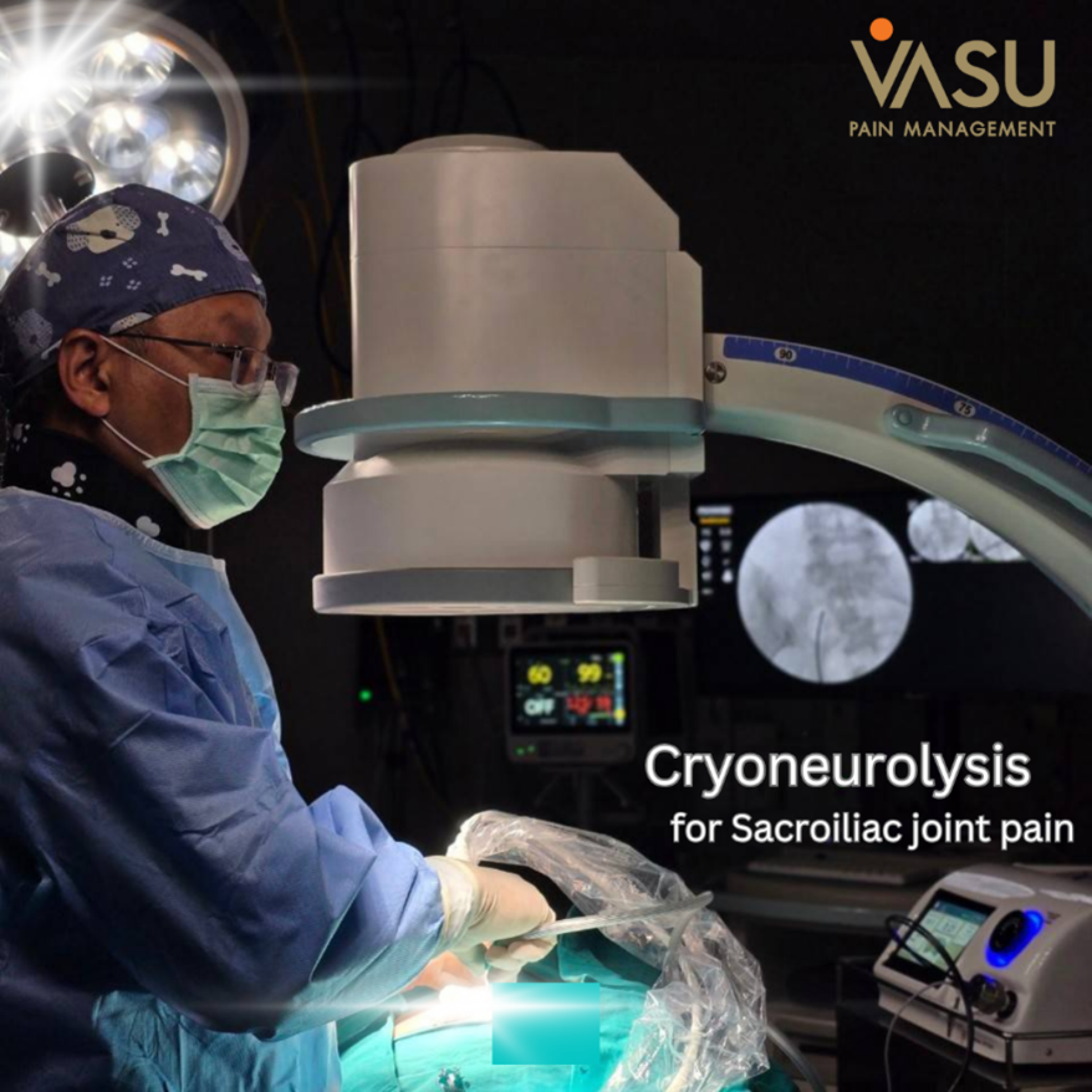Sacroiliac (SI) Joint Pain and Cryoneurolysis Treatment
Last updated: 2 Jun 2025
740 Views

Sacroiliac (SI) Joint Pain and Cryoneurolysis Treatment
The sacroiliac (SI) joint connects the spine to the pelvis and plays a vital role in shock absorption and movement. Dysfunction or inflammation of the SI joint can cause pain in the lower back, buttocks, or radiating into the legs. This pain is often misdiagnosed as sciatica or lumbar disc disease.
Cryoneurolysis for SI Joint Pain
Cryoneurolysis is a non-surgical treatment that uses extreme cold to temporarily interrupt the function of the lateral branch nerves, which carry pain signals from the SI joint to the brain. By disrupting these nerves, the procedure helps significantly reduce pain.
Steps of Cryoneurolysis Treatment
1. Evaluation and Diagnosis
A thorough physical exam and medical history are performed to confirm that the SI joint is the true source of pain and to rule out other causes.
2. Diagnostic Block
Before proceeding with cryoneurolysis, a diagnostic nerve block is performed by injecting a small amount of local anesthetic to the target nerve. If the patient experiences significant temporary pain relief, this confirms that the pain is nerve-related and that they are a good candidate for cryoneurolysis.
3. Local Anesthesia
On the day of the procedure, local anesthesia is administered again to ensure patient comfort during the cryoneurolysis.
4. Cryoneurolysis Procedure
Using imaging guidance such as ultrasound or fluoroscopy, a thin probe is inserted near the targeted nerves. The probe delivers a burst of extreme cold to interrupt nerve function. Each treatment site takes only a few minutes.
Advantages of Cryoneurolysis
Minimally invasive with no incisions.
Targeted pain relief at the specific nerve branches.
Repeatable if pain returns over time.
May reduce or eliminate the need for pain medications.
Quick recovery with most patients resuming activities within a few days.
Considerations
Temporary effect pain relief typically lasts 6 to 12 months
Varied response results differ from patient to patient
Mild side effects temporary numbness, soreness, or bruising at the site
Does not cure underlying joint degeneration treats symptoms, not the cause
Expected Results
Most patients report significant pain reduction within days after the procedure. Improved mobility, better function, and reduced reliance on medications are common benefits. Many patients can more fully engage in physical therapy and daily activities, which further supports long-term outcomes.
Cryoneurolysis is an excellent option for patients with confirmed SI joint dysfunction who have not found relief through physical therapy, medications, or injections. A proper medical evaluation is essential to determine your suitability for the procedure.
The sacroiliac (SI) joint connects the spine to the pelvis and plays a vital role in shock absorption and movement. Dysfunction or inflammation of the SI joint can cause pain in the lower back, buttocks, or radiating into the legs. This pain is often misdiagnosed as sciatica or lumbar disc disease.
Cryoneurolysis for SI Joint Pain
Cryoneurolysis is a non-surgical treatment that uses extreme cold to temporarily interrupt the function of the lateral branch nerves, which carry pain signals from the SI joint to the brain. By disrupting these nerves, the procedure helps significantly reduce pain.
Steps of Cryoneurolysis Treatment
1. Evaluation and Diagnosis
A thorough physical exam and medical history are performed to confirm that the SI joint is the true source of pain and to rule out other causes.
2. Diagnostic Block
Before proceeding with cryoneurolysis, a diagnostic nerve block is performed by injecting a small amount of local anesthetic to the target nerve. If the patient experiences significant temporary pain relief, this confirms that the pain is nerve-related and that they are a good candidate for cryoneurolysis.
3. Local Anesthesia
On the day of the procedure, local anesthesia is administered again to ensure patient comfort during the cryoneurolysis.
4. Cryoneurolysis Procedure
Using imaging guidance such as ultrasound or fluoroscopy, a thin probe is inserted near the targeted nerves. The probe delivers a burst of extreme cold to interrupt nerve function. Each treatment site takes only a few minutes.
Advantages of Cryoneurolysis
Minimally invasive with no incisions.
Targeted pain relief at the specific nerve branches.
Repeatable if pain returns over time.
May reduce or eliminate the need for pain medications.
Quick recovery with most patients resuming activities within a few days.
Considerations
Temporary effect pain relief typically lasts 6 to 12 months
Varied response results differ from patient to patient
Mild side effects temporary numbness, soreness, or bruising at the site
Does not cure underlying joint degeneration treats symptoms, not the cause
Expected Results
Most patients report significant pain reduction within days after the procedure. Improved mobility, better function, and reduced reliance on medications are common benefits. Many patients can more fully engage in physical therapy and daily activities, which further supports long-term outcomes.
Cryoneurolysis is an excellent option for patients with confirmed SI joint dysfunction who have not found relief through physical therapy, medications, or injections. A proper medical evaluation is essential to determine your suitability for the procedure.